12.7mm Breda-SAFAT
Spoiler
Before 1938:
12.7mm Ball ~36g. Lead core with aluminum tip

12.7mm Tracer ~36g.

12.7mm Incendiary (WP) ~36g. ~1-1.3g WP in the nose.

1938:
12.7mm AP ~37g. Ordinary steel core.

12.7mm API (WP) ~35g. Shortened steel core. Crimped nose. Bleeds WP after firing. ~1-1.3g WP.

12.7mm HE ~35g. ~0.8g PETN + ~0.25g in fuze. Red Band.

12.7mm HEI ~35g. ~0.15g PETN + ~0.25g in fuze + ~1g Flashpowder with TNT. Blue Band.

1939:
12.7mm API-T ~37g. Shortened steel core. Flashpowder in the nose.

12.7mm HEI-T ~37-38g. ~0.15g PETN + ~0.25g in fuze + ~0.6g Flashpowder with TNT. Yellow Band.

12.7mm HEI-T (SD). Self-destroying by tracer. Blue band. Otherwise same as above.

1940:
Production stop of Tracer, HE, HEI and probably API (WP) and Incendiary
12.7mm API ~37g. Ordinary steel core. Thermite or Flashpowder in the nose.

1942:
12.7mm API. Flat nose. Otherwise identical to regular API.

12.7mm Ho-103
Spoiler
From 1941 onwards:
12.7mm Ball. 36g. Similar construction to British and Italian Ball ammo. Hard lead core with aluminum tip.

12.7mm AP-T. 36g. Black identification band. Later White (high grade steel) + Green (tracer) band

12.7mm Tracer. 36g. Identical to AP-T but using low grade steel. Green band

12.7mm Ma-103 HEI (fuzed). ~34.4g. Japanese copy of Italian HEI bullet with Japanese built fuze. ~0.6g RDX + 1.0g Flash powder.

From 1942 onwards:
12.7mm Ma-102 HEI (fuzeless). ~32.2g. Greater capacity than fuzed bullet but also heat sensitive. 1.65g PETN/RDX + 1.0g Flash powder.

12.7mm Berezin UB
Spoiler
Before 1938:
12.7mm B-30 AP ~52g.
Around 1938:
12.7mm B-32 API ~49g. ~1g Flash powder in the nose instead of soft lead. Otherwise identical to B-30 AP
In 1940:
12.7mm MD HE ~43.5g. 1.9g PETN + 0.1g in striker type fuze.

When introduced in 1941:
12.7mm BZF-46 API (WP) ~46.5g. ~1.2g WP behind shortened steel core. Supposed to ignite fuel in armored tanks.

12.7mm MD-46 HE ~43g. ~2.4g PETN with air compression fuze.

12.7mm MDZ-46 HEI ~43.5g. ~1.65g PETN + 1.2g Flash powder with air compression fuze.

In 1944:
12.7mm MDZ-3 HEI ~37g. ~1.9g PETN + ~1.3g Flash powder with air compression fuze. Simplified design with higher capacity.

20mm ShVAK
Spoiler
Till end of 1941:
20mm OF shell (HEF) 91g. ~3.3g Tetryl or GTT (1939). Fragmentation groves on shell body.

20mm OFZ shell (HEFI) 91g. 0.85g Tetryl or GTT (1939) + 3.9g Flash Powder. Fragmentation groves on shell body

20mm Practice shell. 91g. Inert OF shell without fragmentation groves and dummy fuze. Only used for gun sighting and testing.
No Picture :(
20mm T shell (Tracer) 91g.
No Picture :(
Early 1941:
20mm BZ shell (API) 96.6g. 2.8g Flash powder pellet ring (DU-5)

Late 1941:
20mm OZ shell (HEI) ~96g (technically HEFI). 2.8g GTT + 3.4g Flash powder pellet (DU-5)

Early 1942:
20mm OZ shell (HEI) 96g (technically HEFI). ~3g A-IX-2 instead of GTT (quickly replaced the previous filled shell). Otherweise identical.

Early 1943:
20mm OZT shell (HEI-T) 96g (technically HEFI-T). Probably 2.3g A-IX-2 + 2.5g Flash powder pellet (DU-5)

Sometime between 1943-1944:
20mm OZ shell (HEI) 96g -> 5.6g A-IX-2 (replaced incendiary charge)

20mm OZT shell (HEFI-T) 96g -> 4.13g A-IX-2 (replaced incendiary charge)

23mm VYa
Spoiler
1941:
23mm OZ shell (HEI) 201g (technically HEFI). ~10.2g GTT and 6.5g DU-5 Flash Powder pellet

23mm BZ shell (API) 196g. 6g DU-5 incendiary pellet in the nose.

Early 1942:
23mm OZ shell (HEI) 201g (technically HEFI). 15.6g A-IX-2.

23mm BZ shell (API) 199g. 6g DU-5 incendiary pellet in the nose. Simplified and improved design using a shorter steel penetrator.

Early 1944:
23mm OZT shell (HEI-T) 196g (technically HEFI-T). 11g A-IX-2

13mm MG 131
Spoiler
Till mid 1943:
13mm Spgr.L'spur (HE-T) 34g. 1.1g PETN + 0.2g in detonator. Replaced by Brsprgr.L'spur. 750m/s

13mm Brsprgr.L'spur (HEI-T) 34g. 0.9g PETN + 0.2g in detonaror + 0.3g Thermite. 750m/s

Mid 1943:
13mm Pzbrgr.(P) (API) 38g. ~0.86g WP in light metal capsule. Only short production run. 710m/s. Very poor ballistics.

Late 1943:
13mm Brgr.L'spur (IT) 32g. ~2.6g Flashpowder. Cardboard head beneath sheet metal nose cap holding a percussion Cap. 770m/s

Mid 1944:
13mm Brgr. (Inc) 32g. ~2.8-3g Flashpowder. No tracer but similiar construction to tracer shell. 770m/s

13mm Brgr.L'spur (IT) 34g. 2.2g Flashpowder. AZ 1535 Nose fuze. 750m/s.

15mm MG 151
Spoiler
Till 1943:
15mm Pzgr.L'spur (AP-T) 72g. 850m/s

15mm Brsprgr.L'spur (HEFI-T) 57g. 1.9g PETN (+0.16 in detonator) + 1.3g Thermite. 960m/s

Mid 1943:
15mm Brgr.L'Spur (SD) Inc-T 57g. 4.9g Flash powder. 960m/s

Mid 1944:
15mm Pzbrgr. (P) (API) 59g. ~0.86g WP filler in light metal capsule. 960m/s

20mm MG 151/20 and MG FF/M
Spoiler
Until mid 1942:
- 20mm Sprenggr.L’spur SD (HEF-T). 115g. 3.7g PETN (+0.6g inside detonator).
- 20mm Brsprgr.L’Spur (HEFI-T) 115g. 115g ~3.7g PETN (+0.6g inside detonator) + 0.4g Thermite.
- 20mm Brsprgr.L’Spur SD (HEFI-T) 115g. 115g ~3.1g PETN (+0.6g inside detonator) + 0.4g Thermite.
- 20mm Brsprgr.L’Spur (HEFI-T) 115g. 2.3g PETN (+0.6g inside detonator) + 2.1g Thermite. With and w/o SD.
- 20mm M-Gesch. (HE-Mine) 90g. 17g PETN (+0.6g in detonator). With and without self-destruct mechanism.
- 20mm Pzgr. (AP) 115g.
- 20mm Pzsprg. (APHE) 115g. 5.1g PETN
Later half of 1942:
- 20mm M-Gesch. (HE-Mine) 92g. 18.6g HA 41 (+0.6g PETN in detonator). With and without SD + fuze delay charge.
- 20mm Pzbrgr. (P) (API) 115g. 3.6g WP in 8.6g Aluminum capsule.
- 20mm Pzbrgr. (E) (API) 117g. ~2g WP in Elektron capsule.
Early 1943:
- 20mm Brgr. (Inc) 117g. 15-18g Flash powder. Using reinforced Mineshell body.
- 20mm Brgr.L’Spur (IT) 115g. 8g Flash powder + 1.5g in the nose.
Mid 1943:
- Weight increase: 115g shells → 117g
- Mineshell: 92g → 94-95g
Late 1943:
- 20mm Brgr.L’Spur SD (IT) 117g. 8g Flash powder. Hollow nose.
- 20mm Brgr.L’Spur SD (IT) 117g. Larger cavity for ~10g Flash powder. Hollow nose.
- 20mm M-Gesch. X SD (HEI) 104g. 25g HA 41. Presumably only produced in low quanitity and originally for AA guns.
Late 1944:
- 20mm Brgr. 44 (Inc) 106g. ~15g HA 41 (+0.6g PETN in detonator). Hydrostatic fuze.
30mm MK 108
Spoiler
Till 1943:
Early 1943:
Some were also filled with pure PETN instead. Designed for mass production.
Early 1944:
Mid to late 1944:
30mm M-Brgr. (HEI) 370g. ~40g HA 41 + 8-10g Flash powder or Thermite inside 20mm hollow steel tube.

Intended to replace both Mine and Incendiary shells but probably didn’t due to the added complexity.
Late war development:
30mm MB shell. Unknown weight. Probably 80g or more pressed HA 41. Bottom fuze.

Shape similiar to 30mm Mine w/ tracer but can be filled with pressed explosive.
20mm Hispano Mk. II and V
Spoiler
Need to investiage some more.
The general evolution is:
HE and HE-T → HEI
Ball → AP and AP-T → SAPI
Probably around 1940:
(Most likely French shells)
Spoiler
20mm HEF 130g. ~8-10g Pentolite.
Spoiler
20mm HEF-T 130g. 5g Pentolite.
20mm Practice Ball. 130g. Armor penetration: 15mm at 100m (150kg/mm²).

Probably around 1941:
20mm HEFI 131g. Replaced HEF. 5.6g Tetryl + 5.7g flash powder.
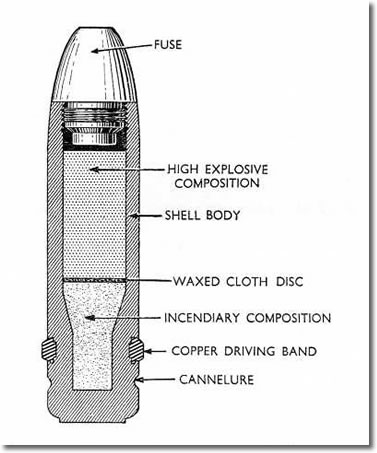
Probably around 1942:
20mm AP Mk. II ~131g. Armor penetration: 26mm at 100m (150kg/mm²)
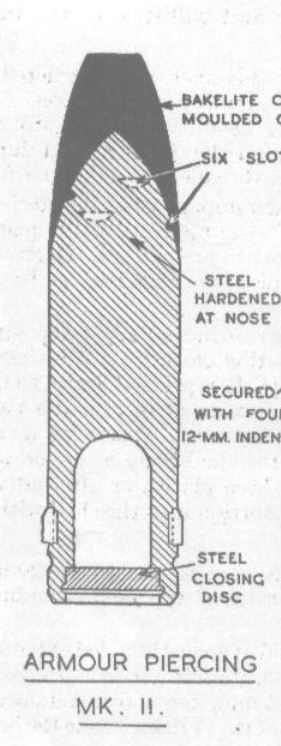
Probably around 1943:
20mm SAP-I 131g. 11.66g Flash powder with armor piercing nose. Penetration: 26mm at 100m (53kg/mm² ship steel)
- AP-T 133g. Added tracer elements to previously hollow section.
Probably around 1944:
20mm SAP-I 131g. Reduced filler to 9g, added detonator below steel nose
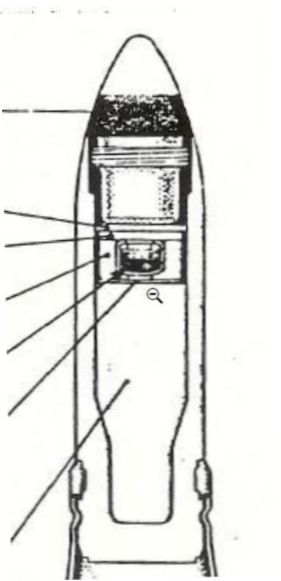
With Ball being heavily relied on till 1943 or even 1944 since AP was only really necessary for attacking armored ground targets. SAPI was produced in 1943 and become the standard shell for air combat together with the Mk. 1 HEI.
It seems that in 1943 the ammunition development for WW2 was finished and the ammo types used were:
- 20mm Ball
- 20mm Tracer
- 20mm AP and/or AP-T
- 20mm HEI
- 20mm SAPI
20mm AN/M1 M2 and M3
Spoiler
Mid 1941 till end of 1945:
- 20mm Ball ~131.5g. Hollow steel shell. Penetrates roughly 15mm of HHA at 100m.
Beginning of 1942 till beginning of 1944:
- 20mm Mk. 1 HEI ~131.5g. ~11.27g filler consisting of roughly 5.6g Tetryl and 5.7g Flash Powder. No. 253 air compression fuze.
- 20mm M75 AP-T ~167.7g. Solid steel projectile.
Mid 1944:
- 20mm M95 AP-T ~131.5g. Solid shot with ballistic cap.
- 20mm M96 Incendiary ~122.4g. 10.8g Flash Powder in body and thin nose.
- 20mm M97 HEI ~131.5g. 7.7g filler consisting of roughly 5.6g Tetryl and 2.1g Flash powder. M75 air compression fuze.
20mm Type 99-1 and 99-2
Spoiler
Dates are currently unknown.
Velocity generally:
- 600m/s Type 99-1
- 750m/s Type 99-2)
Basic types are:
20mm Basic HE (HEF) 127.6g. 9.9g Pentolite. Similiar to Swiss manufactured shell.
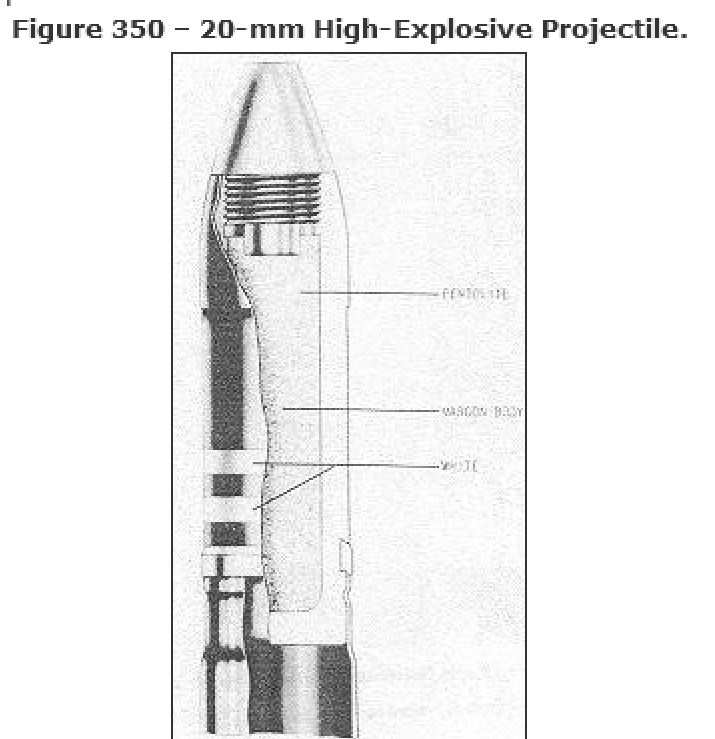
20mm HE-T (HEF-T) 127.9g. 5.1g Pentolite. 6.5g! of tracer composition.
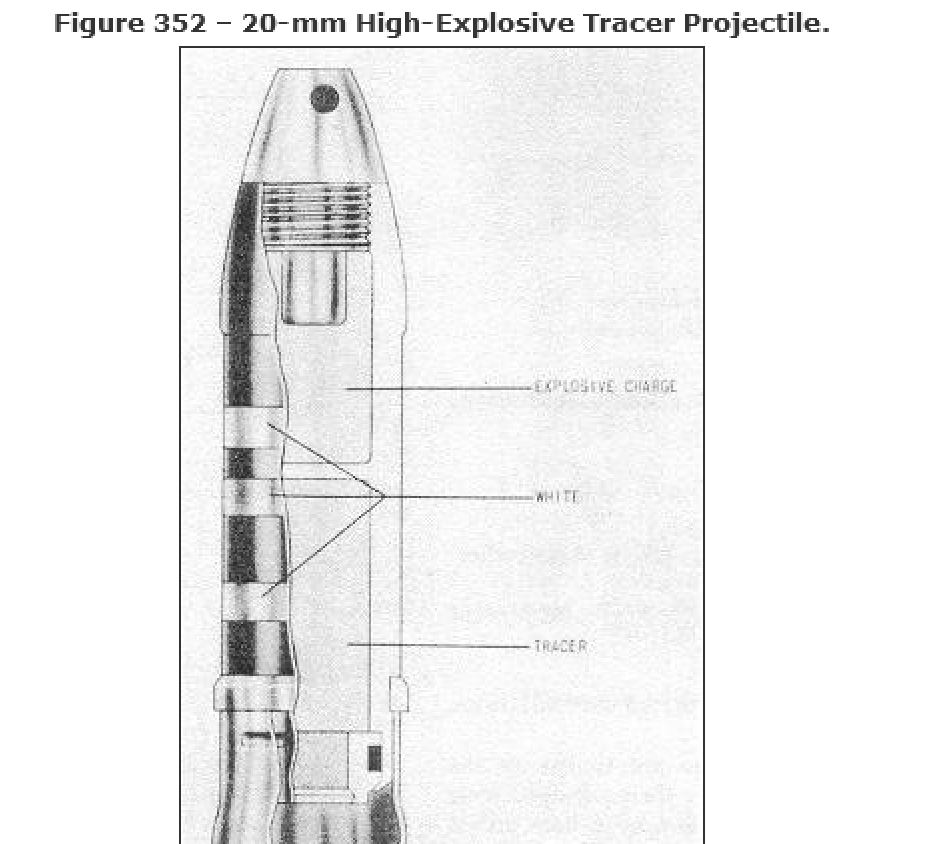
20mm HE-T *SD (HEF-T *SD) 127.6g. 4.25g Pentolite. 5.67g of tracer composition. Similiar to Swiss manufactured shell.
20mm HEI Model 1 (HEFI) 127.9g. 5.1g TNT, 1.1g Incendiary mixture (nitrocellulose based), 3.1g WP.
20mm API 131g. 4g Incendiary composition (nitrocellulose based). Fuzeless. Base breaks on impact with armor, igniting the filler.
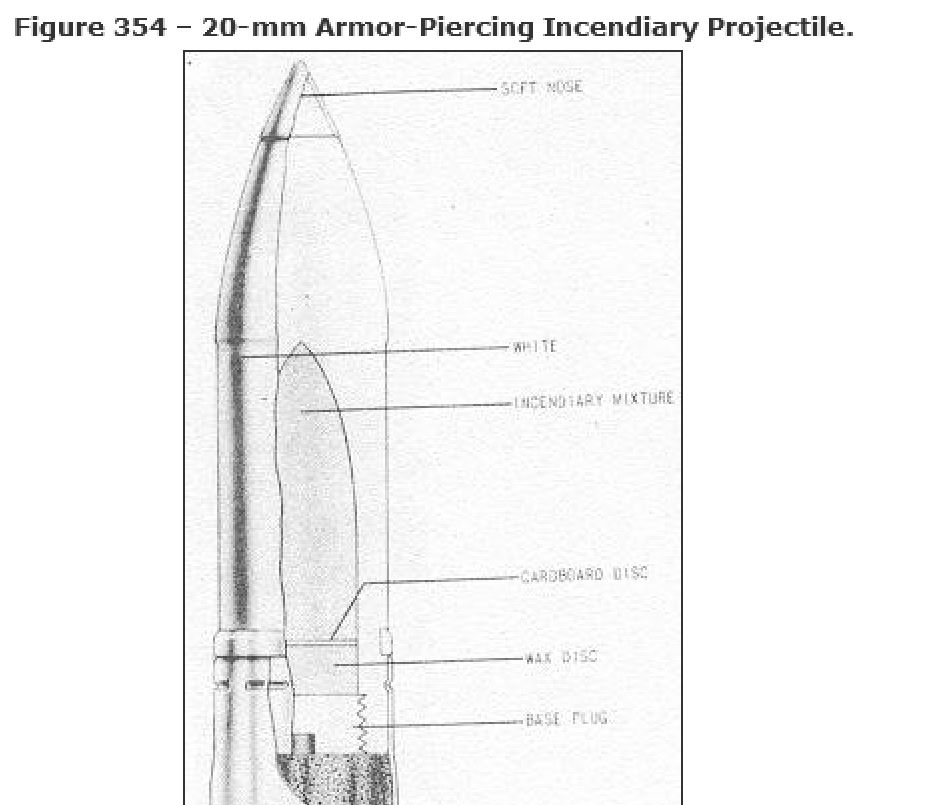
20mm Tracer 125.9g. 8.79g Tracer composition.
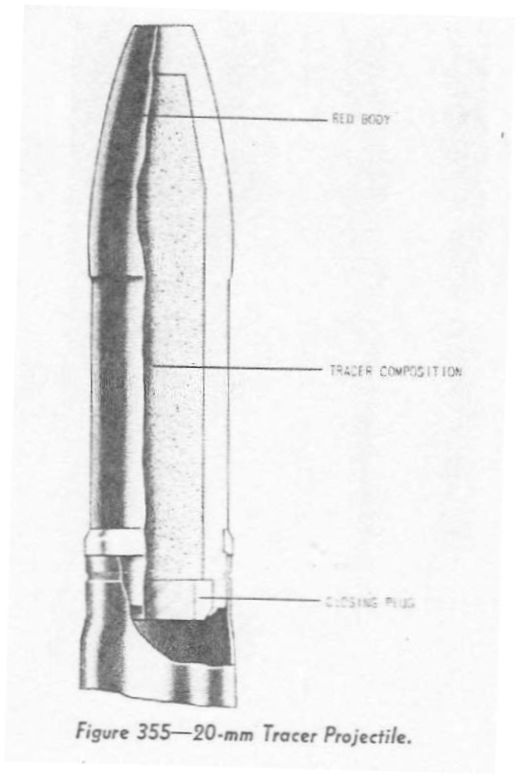
Later modifications:
20mm HE-T Mod. II (HEF-T) 127.6g. 5.38g Pentolite. 5.95g of tracer composition.
20mm HEI Model 1 Mod. I-III (HEFI) 128g. 3.6g TNT, 1g Incendiry mixture, 2.6g WP. Tapered cavity. Reduced explosive charge to stop the WP from burning up instantly. Different fuze depending on modification.
20mm HEI Model 1 Mod. IV (Inc) 130g. 0.58g TNT w. aluminum, 5.7g WP. Eliminated the TNT, except below the fuze detonator. Air column fuze.
Early 1944:
20mm HEI Model 2 (Inc) 125.6g. 800m/s. Copy of IJA fuzeless design. Head: ~2.5g RDX/PETN. Body: 12.5g magnesium based flash powder.
Sources (incomplete):
- Soviet Cannon. A Comprehensive Study of Soviet Guns and Ammunition in Calibres 12.7mm to 57mm. By Christian Koll - 2009
- Боеприпасы к авиационным пулеметам и пушкам - 1953
- L.Dv. 4000/10 Munitionsvorschrift für Fliegerbordwaffen
- Handbuch der Flugzeugbordwaffen Munition 1936 - 1945
- Japanese Projectiles Volume 1. CINCPAC - CINCPOA Bulletine No. 85 - 45. April 1945
- Japanese Ammunition Part III - 20mm. Miliatry Intelligence Division, War Department Washington, D.C. - July 1945
- Some Private Website about Italian ammunition: munizioni - Le 12.7 Breda Mod.35

















